Content [show]
Download Original] ’class =" imagefield imagefield-lightbox2 imagefield-lightbox2-resizeimgpost-500-500 imagefield-field_imgblogpost imagecache imagecache-field_imgblogpost imagecache-resizeimgpost-500-500 imagecache-field_imgblogpost-resizeimgpost-500-500 ″>
Juniper grows in the wild and is also planted in summer cottages. It perfectly decorates the territory, complementing the flower beds. But you can grow indoor
juniper
... At home, it forms a beautiful small tree.
It will not only complement the interior, but also purify the air, as it fights bacteria well. This plant does not like dry air, heat. Do not forget about these and other nuances so that the juniper can develop normally in indoor conditions. If you do not adhere to simple rules, the plant will die.
Content:
- Reproduction of juniper
- Basic care guidelines
- Growing conditions and care
- Plant transplant
Reproduction of juniper
In wild nature
reproduction
Juniper occurs with the help of seeds that are formed in the berry cones. But in indoor conditions this will bring a lot of trouble, so it is better to propagate the plant by cuttings. In this way, the appearance of the mother juniper is preserved.
But this procedure should be done with plants that are more than 8 years old. In the spring, a stalk is cut, the length of which reaches 10 centimeters. It is planted in a peat mixture with sand, put in the shade and covered with foil. The plant needs regular spraying. It will take 1-2 months, and roots will begin to appear. During this period, juniper is transplanted.
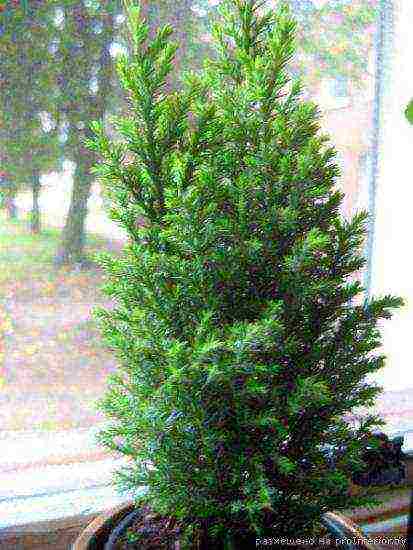
For growing at home, it is better to choose a Chinese type of plant. If we compare all varieties of juniper, then the Chinese variety needs the mildest wintering conditions.
If a person has decided to grow this plant in his room, it is not necessary to look for where to find
stalk
and then wait for it to take root. To do this, you can go to a nursery or a special store where young junipers are purchased. But it differs from other indoor plants and requires special care.
Basic care guidelines
It is easy to take care of a juniper indoors, for this you need to take into account some recommendations. The plant does not tolerate stagnant moisture. Otherwise, root diseases may appear, leaves will begin to fall off. To avoid such problems, do not water the juniper too much. The room where the plant is located should have excellent air circulation.
Junipers need pruning every year. This procedure is carried out at the end of winter. Pruning is also done for plants that develop
in the open field
... It is at the end of winter that the juniper begins to grow intensively, therefore gardeners are advised to transplant the plant into another container. You also need to do root trimming, but this procedure should be repeated no more than once every 3-4 years.
When indoor juniper is grown, you need to choose a special place for it where it will be located. It is better to put it on the windowsill, which is the coldest in the house. A nearby battery can have a detrimental effect on the condition of the plant.
Video on how you can propagate a juniper:
Therefore, you should create protection for the juniper. To do this, the pot is wrapped in plastic wrap, in this way the plant will be protected from hot air. To do this, fix one side of the film along the window sill, and attach the other along the window, placing it above
juniper
... The main thing is that the plant is not completely covered. Free air must flow to it.
Growing conditions and care
The plant loves light, so you shouldn't hide it in the shade. It should be close to windows. In the summer, you can take the juniper outside, but in winter, a room where there is no heating is ideal for a plant. It easily tolerates low temperatures.
Juniper is adversely affected by heat, dry air and dust. For this reason, spraying should be carried out every day. In order for the plant to develop well, the necessary conditions must be created for it. This is the care of him. Despite the fact that the juniper loves light, you need to choose a place for it, where there is no prolonged sunlight.
In summer, you also need to monitor the temperature. It should not rise above 20 degrees. Periodic exposure to the street is of great benefit to the plant, therefore it is recommended to take it out into the air.
In winter, a loggia or balcony for development is ideal for a juniper. After all, it is in such rooms that the temperature is usually kept low. But we must not forget that the plant is placed near the light. In this period
watering
should be shortened.
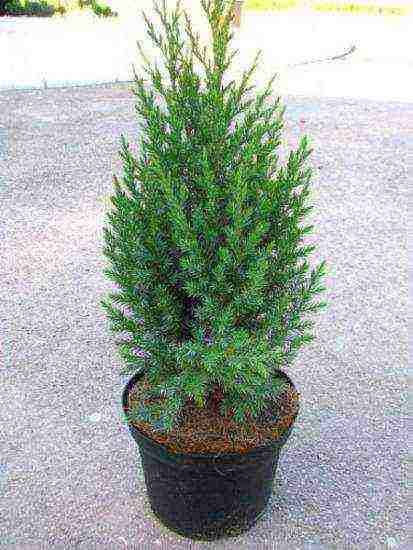
The juniper has some enemies, including:
- caterpillars
- spider mites
- mealybugs
- rust appearance
Therefore, you need to systematically monitor the condition of the plant, provide timely assistance. Indoor juniper should be fed periodically. It is best to use organic fertilizers. Humus is ideal for this. It is rarely allowed to apply mineral fertilizers, but you should not add a lot of them. The plant should be fed in small quantities in the summer.
Plant transplant
Indoor juniper at a young age is transplanted once a year. This procedure is carried out in the spring. When the plant is already quite old, it does not need replanting. It will be enough to change the top layer of the soil. This should also be done annually.
Drainage is considered important for the plant. It is made from a sod-peat mixture to which sand is added.
For Cossack and solid juniper, a small amount of lime is also added to the soil. For the virgin variety
into the ground
you need to add clay. If you adhere to such simple recommendations, the juniper will develop normally and please its owners.
Juniper is an unusually spectacular evergreen with a plastic shape and a varied palette of colors. This original culture is usually grown in gardens and courtyards. But if you wish, you can also decorate a city apartment with juniper. When planted indoors in a tub, this ornamental crop forms a small attractive tree.
Juniper: general description
This plant belongs to the Cypress family. In the wild, some of its species can reach a height of 8-10 meters. However, in the conditions of Russia, the juniper usually forms small, spreading, rather beautiful bushes. Its high forms in nature in our country are quite rare.

The crown of a juniper can have a conical or ovoid shape. The plant is dioecious. That is, there are two varieties of cones on it.Male ones have the appearance of yellow spikelets and are located in the axils of the needles. Female cones are composed of scales and are light green in color. When ripe, they turn into bright blue fruits.
The trunk of a juniper is straight, branching, covered with a grayish bark. The wood of this plant is very beautiful - it has an interesting texture and is distinguished by a pinkish tint. Juniper can grow in nature for up to 600 years.
What varieties exist
This plant is appreciated by lovers of decorative cultures, including for the variety of forms. But, of course, not all junipers can be grown indoors. The types and varieties (with photos), the most suitable for apartments, will be discussed by us below.
It is believed that stunted junipers are best suited for indoor cultivation. For example, you can plant a Blue Star in a pot. It is a very beautiful juniper with blue needles and horizontal shoots. He prefers slightly sour soil. Below is a photo of this particular plant.

Also, lovers of decorative crops often grow a variety of media in an apartment. This hybrid was bred by crossing a common wild juniper and a Cossack one. Its main advantage is considered to be unpretentious in terms of care. How it looks can be seen in the photo.
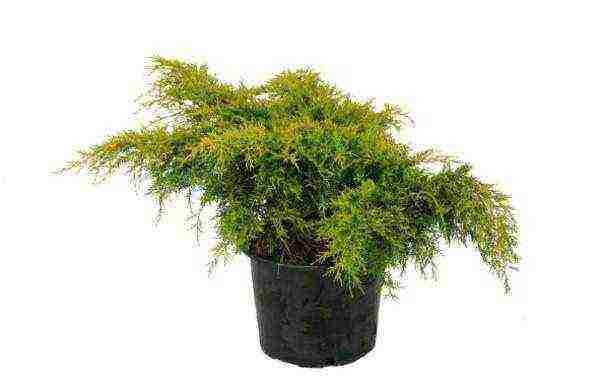
Chinese Blaauw variegata is a low shrub indoor juniper with branches growing straight up. This is another popular variety among fans of ornamental plants. It looks very nice in a tub. His photo is presented below.
These are the junipers most often grown in apartments. Species and varieties (with a photo, it will be easier for lovers of ornamental plants to decide on the most suitable juniper), these are actually very beautiful. But if you wish, you can grow at home, of course, other varieties of this culture. Very attractive varieties are, for example, Squamata, Sabina, etc.
Propagation by cuttings
Ornamental junipers can of course be purchased from a specialist store. However, such plants are not always available for sale. Therefore, many indoor crop lovers simply grow juniper from a cuttings taken from a bush in the country or in the forest. It is not difficult to get an adult plant using such planting material.
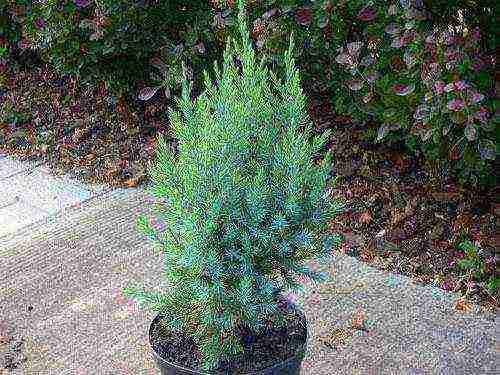
Cuttings for cultivation should be taken only from a young bush (at the age of 4-5 years). You cannot cut off a branch for planting with a knife. Otherwise, the plant will not be accepted. The stalk should be broken off together with the "heel". The latter needs to be cleaned from the bark in the future. Before planting, the lower needles should also be cut off from the handle with scissors.
The twig prepared in this way must be placed in a pot with a nutritious substrate. As the latter, ordinary moistened garden soil mixed with river sand is perfect. The cutting should be placed in the substrate at an angle of about 35 degrees. In order for the twig to sprout roots and begin to develop, you need to put a plastic bag on the top of the pot, thus arranging a "greenhouse". It is not recommended to water the cutting in the future. Before rooting (30-45 days), it should only be sprayed.
Sometimes twigs planted in this way are not accepted. Therefore, for fidelity, you can take several cuttings at once. In this case, instead of a pot, you should use a box or simple plastic cups.
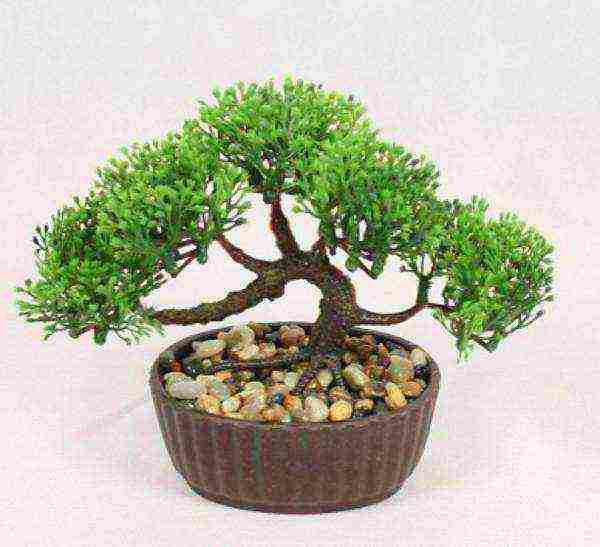
Another way to land
Cuttings, in order to get an adult indoor juniper, are usually used only from mid-May to early July. At a later time, branches rooted directly in the garden should be used as planting material.
It will also be very easy to get juniper cuttings if desired. To do this, the lower branch of a young plant just needs to be pressed horizontally to the ground and pinned in this position.The end should be bent vertically and attached to a peg. The place where roots should form on the branch in the future must be constantly kept moist.
Where to put in the apartment
The juniper plant is not too demanding for environmental conditions. In the wild, it feels good both in the shade of large trees and on the strongly heated “bare” slopes of mountains and hills. However, with sufficient lighting, the decorative qualities of this culture are significantly improved. Therefore, it is best to put a pot of juniper in the room on the sill of the east or west window. This plant is not afraid of direct sunlight. However, they still should not affect its branches and needles for too long. Otherwise, the bush will dry out.
It is also possible to achieve an improvement in the decorative qualities of a juniper in an apartment by increasing the humidity of the air. This plant does not like dryness. If the air humidity in the room is insufficient, the juniper will not die. But some of his needles, unfortunately, will begin to turn yellow. To prevent this from happening, the juniper should be sprayed periodically.

In summer, it is advisable to take the pot with the plant to the balcony or take it to the country. Staying outdoors, as well as spraying, will have a positive effect on the decorative properties of the juniper.
In winter, plant pots should be placed in the coolest part of the room. Under no circumstances should they be installed next to batteries. Otherwise, the juniper may die.
How to water
This decorative culture absolutely does not tolerate stagnation of moisture. Therefore, watering indoor juniper should be moderate. Bogs in a pot with this plant cannot be arranged. Juniper is not afraid of drying out the soil. Without water, it can grow for quite a long time. In gardens, this ornamental plant is often not watered all summer. However, in a pot without periodic moistening, the juniper will still lack nutrients. Therefore, it is still worth watering it at least once a week.
How to fertilize
With regard to top dressing, homemade juniper is also relatively unpretentious. When grown indoors, adult trees are fertilized a maximum of one or two times during the warm season. Young people are fed mainly with mineral compounds. Most often, special mixtures are used for juniper intended for coniferous ornamental crops. They are brought into pots with young plants about once a month. Fertilizing juniper with organic matter (manure or humus) is strictly prohibited. The use of such dressings can lead to deformation of the crown of the tree.
How to trim
In most cases, indoor juniper does not need to form a crown. All that is needed to make the plant look attractive is to remove dried and growing branches from the bush. If the juniper looks too asymmetrical, you can also trim the crown a little on the desired side.

When pruning junipers, you should be guided by the principle - less is better than more. If too many branches are removed from the plant, it can slow down growth.
Plants of the genus juniper can be grown not only in personal plots, but also at home, forming them into a standard dwarf tree or bonsai. In this case, the top layer of bark is removed from young plants, and visually the impression is created of an old tree that has seen a lot in its lifetime. To enhance the effect, bonsai are usually planted on stones, creating an appropriate entourage. The crown of the required shape is formed with the help of wire, branches that are too long should be cut off (pruning is best done with the onset of spring).
Decorative juniper is able not only to please the eye, but also, having strong bactericidal properties, purify the air for several meters around.However, when growing a juniper at home, do not forget that these plants do not tolerate dry air and high temperatures. If the indoor juniper is in a hot room, it will quickly die. For this reason, it is extremely important to create comfortable conditions to which plants of this genus are accustomed in nature - to provide access to light, maintain a sufficiently low temperature in winter, and regularly ventilate the room.
For cultivation at home, Chinese juniper (Juniperus chiensis) is best suited. Of all the plants of the juniper genus, it requires milder wintering conditions, being in the cold season in the open field, it often freezes, especially for young seedlings. The extremely slow growth of Juniperus chiensis allows you to maintain the compact, neat shape of a houseplant for a long time.
Dwarf forms of Chinese juniper Japonica Aureo-variegata (shrub with golden-variegated needles) are especially good for ornamental planting at home,
Aurea (with golden needles)
and Alba (with white needles).
Solid juniper (Juniperus rigida) is also suitable for indoor cultivation. Like the Chinese juniper, it grows extremely slowly and is long-lived.
With the onset of cold weather, a decorative home juniper, a photo of which is widely presented on this page, is best kept in a winter garden, on a loggia or balcony. In this case, the plant will be provided with the necessary temperature regime and sufficient air access. Moreover, not only decorative juniper, but also other indoor plants can winter in such conditions, because for the wintering of most of them the temperature should not exceed + 12 ° С.
Indoor juniper and plant care
Caring for a juniper at home is not difficult, but remember that it cannot stand moisture stagnation. For this reason, in order to avoid problems (root diseases, leaf fall), the plants do not need to be watered too intensively and try to create good air circulation in the room.
Pruning of indoor juniper, like other plants of this genus growing in open ground, is carried out annually at the end of the winter period. At this time, there is an intensive growth of ornamental shrubs, so it makes sense to transplant the plant into another container. Sometimes (no more than once every three to four years) it is necessary to trim the rhizome.
When growing a decorative juniper (see photo) in an apartment, you should choose the coolest windowsill for it. If there is a heating source nearby (battery, heater, etc.), the bonsai flowerpot must be fenced off from the hot air with plastic wrap. To do this, one side of the cellophane covering is fixed along the window sill, and the other is attached over the plant along the window. However, in no case should the plant be completely closed - it is necessary to leave several slots for free air access.
Caring for indoor juniper involves creating conditions for the plant close to natural. It is necessary to choose a sufficiently illuminated place without prolonged exposure to direct sunlight, to ensure sufficient air circulation and the absence of stagnant moisture. In summer, the air temperature should not exceed + 20 ° C; it is useful to periodically expose the plant to the air. The optimum air temperature in winter is from + 10 to + 12 ° C. Since junipers do not tolerate air pollution, the crown of ornamental plants should be regularly sprayed. In winter, the plant should be kept as close to the window as possible, and even better - on the loggia or balcony, providing the required minimum temperature. In the cold season, watering ornamental shrubs should be done as rarely as possible.
Homemade juniper needs a little feeding. It is preferable to use organic fertilizers, for example, humus. Occasionally, you can add mineral fertilizers, but in this case you should not overdo it - feeding is done only in summer and in small quantities.
Young indoor junipers should be replanted once a year, in the spring. Old plants do not need frequent replanting, but it is advisable to replace the topsoil annually. Do not forget about drainage, and the land should consist of a sod-peat mixture with the addition of sand. If a solid or Cossack juniper is grown at home, a little lime must be added to the soil, and a small part of the clay is needed to grow Virginia juniper.
The spectacular juniper (Juniperus) is an evergreen (tree or shrub) of the Cypress family (Cupressaceae). In the wild, its growth is noted throughout the entire Northern Hemisphere (from polar to tropical regions).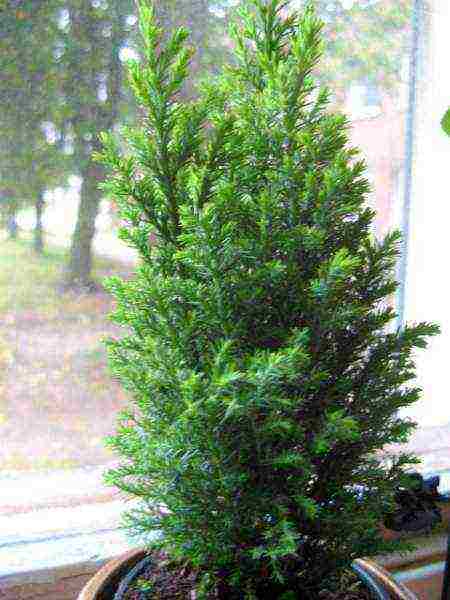
Juniper varieties suitable for home cultivation
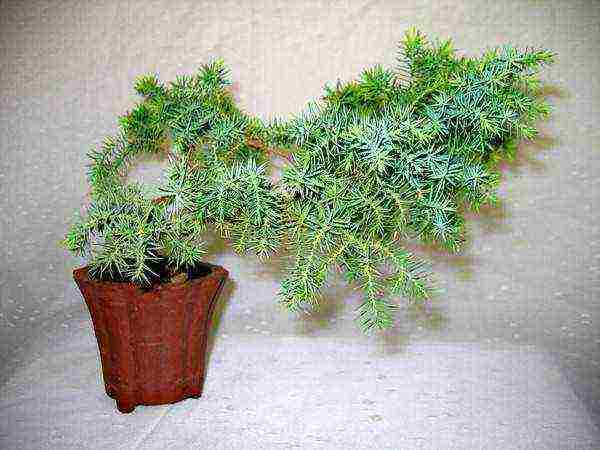 There are many types of juniper, on the basis of which scientists have developed many varieties suitable for growing at home. Having planted this plant in a flowerpot, providing it with proper care, you can count on getting a beautiful tree or bush, which is guaranteed to give a kind of "zest" to any interior.
There are many types of juniper, on the basis of which scientists have developed many varieties suitable for growing at home. Having planted this plant in a flowerpot, providing it with proper care, you can count on getting a beautiful tree or bush, which is guaranteed to give a kind of "zest" to any interior.
The most popular are the Chinese juniper (Juniperuschinensis) and the hard juniper (Juniperus rigida). Under natural conditions, they are capable of reaching significant heights. Indoors, these types of indoor juniper, varieties bred on their basis, planted in pots, show slow growth rates. Providing the recommended temperature and humidity regime, such plants will feel very good at home. You can read the article about Andorra Variegata juniper.
Conditions for home growing juniper
As practice shows, it is not so difficult to grow a magnificent juniper indoors. The main thing is to create the most suitable microclimate for it. The greatest danger to the plant is the hot, dry indoor air.
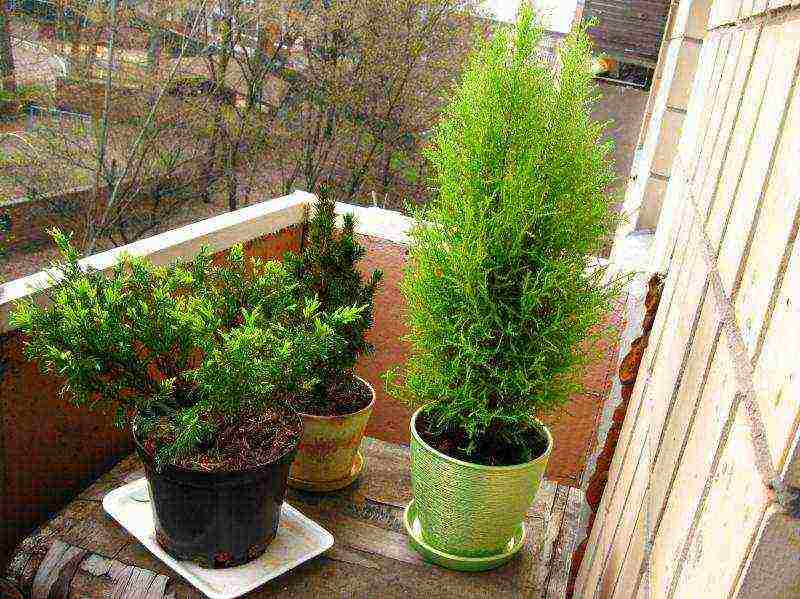 Recommended plant lighting
Recommended plant lighting
Having planted an indoor juniper, you need to immediately provide it with the correct lighting. The plant likes light, but it needs protection from the direct rays of the sun. A bush that grows in the shade in summer and in the sun in winter can die. To prevent this, in the cold season, it is advisable to expose a pot of juniper on a south-facing window. In the warm season, the plant needs to equip the shading and define it on the northern windowsill.
Temperature regime for culture
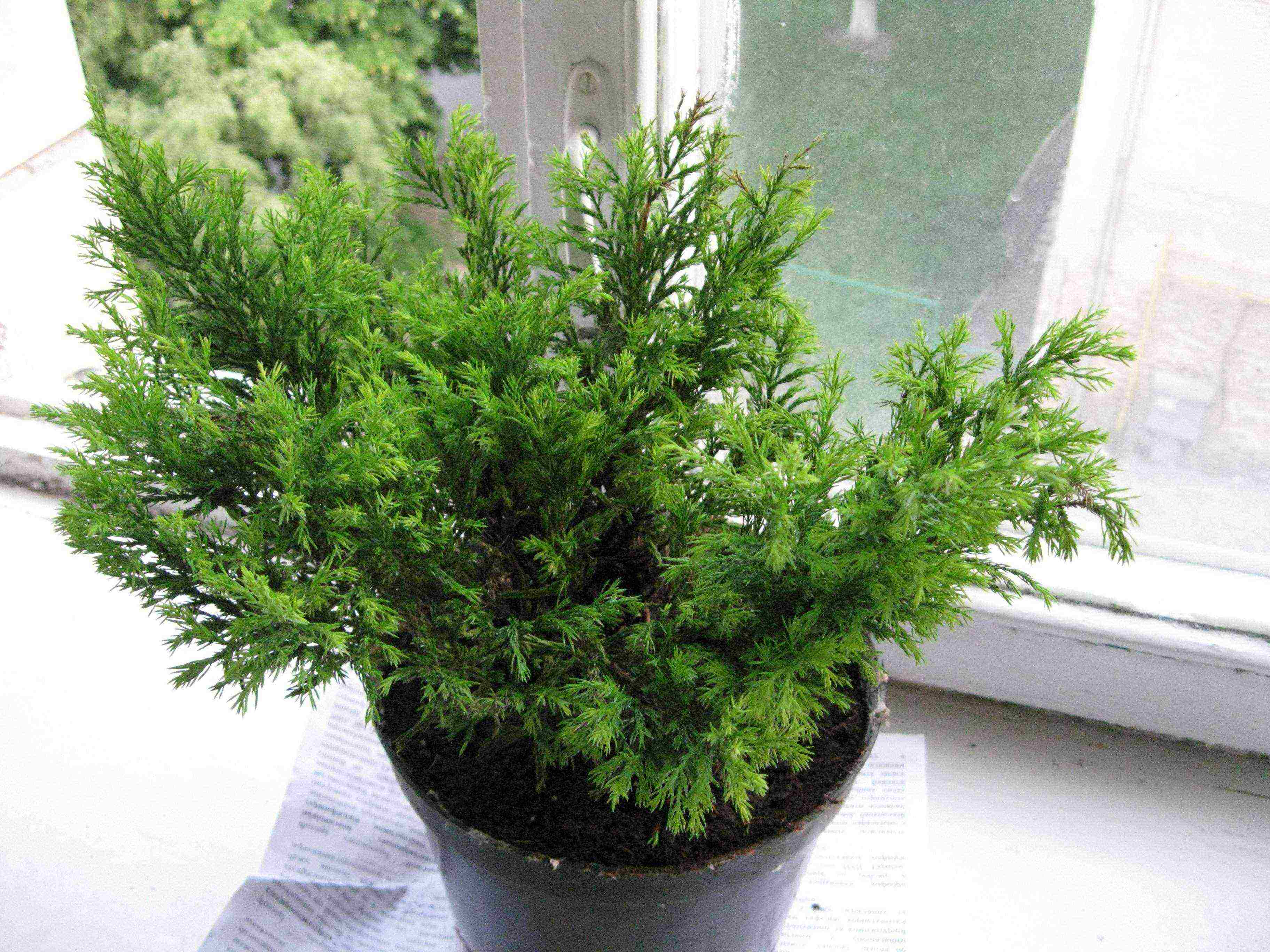 Evergreen juniper - many people strive to grow a houseplant. To be guaranteed to succeed, you will need to pay attention to creating a comfortable temperature regime.
Evergreen juniper - many people strive to grow a houseplant. To be guaranteed to succeed, you will need to pay attention to creating a comfortable temperature regime.
It is very important to exclude overheating of the air. The recommended temperature values should not exceed + 20 ° C. At the same time, the bush reacts negatively to excessive hypothermia. In winter, it is necessary to control temperature fluctuations, the values of which are below + 13 ° C can negatively affect the health of the plant.
In the summertime, taking out the flowerpot to the balcony or street is encouraged. It should be taken into account that the home juniper, which loves fresh air, reacts negatively to drafts.
The choice of planting capacity
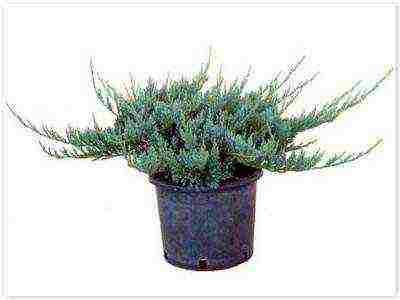 The pot provided to the bush should be free enough, since members of the Cypress family grow well if their root system has enough room for development.It will be mandatory to arrange a drainage layer (broken brick, gravel, expanded clay) at the bottom of the planting container.
The pot provided to the bush should be free enough, since members of the Cypress family grow well if their root system has enough room for development.It will be mandatory to arrange a drainage layer (broken brick, gravel, expanded clay) at the bottom of the planting container.
The choice of containers for the manufacture of which natural materials are used is welcomed: ceramics, clay, porcelain. In addition, it is worth paying attention to the shape of the flowerpot, the presence of a beautiful pattern on its surface, in harmony with the appearance of the plant.
Soil quality requirements
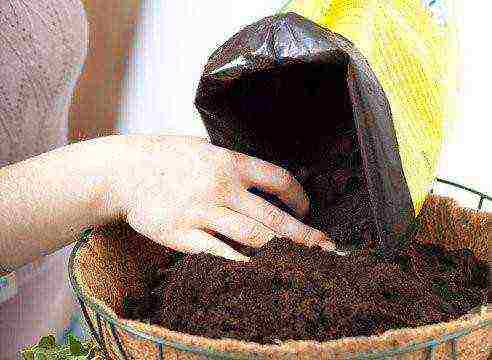 Juniper at home in a pot will grow best in a planting container filled with porous soil. This will ensure uniform access of moisture to the root system.
Juniper at home in a pot will grow best in a planting container filled with porous soil. This will ensure uniform access of moisture to the root system.
Despite the prevailing opinion that this representative of the Cypress family is undemanding to the quality of the soil, it is necessary to give preference to planting it in a soil mixture with the following composition: sod land, sand, peat. The addition of nitrophoska or any other universal fertilizer purchased in a specialized store to the soil is also encouraged.
Reproduction of juniper: basic methods
The most widespread are two methods of reproduction of juniper: the seed method, as well as cuttings. Each of them has its own nuances, advantages and disadvantages.
Seed breeding method
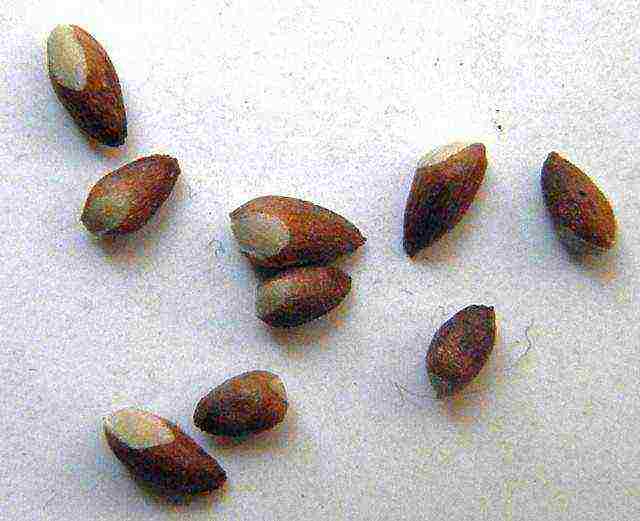 When studying information on how to propagate a juniper at home using seeds, you need to take into account the low efficiency of such a procedure due to the poor germination of planting material. In most cases, this method is the choice of breeders.
When studying information on how to propagate a juniper at home using seeds, you need to take into account the low efficiency of such a procedure due to the poor germination of planting material. In most cases, this method is the choice of breeders.
Having decided to breed juniper from seeds at home, it is advisable to hold this event in the fall. As a container, it is worth choosing boxes that are taken out into the street during the cold season and left for 4 months in the open air. The preserved hardened seeds are planted in pots at the end of spring.
The containers are placed in a well-lit place. Seedlings need timely watering, which prevents the soil from drying out. You can count on the emergence of seedlings next year.
Cutting indoor juniper
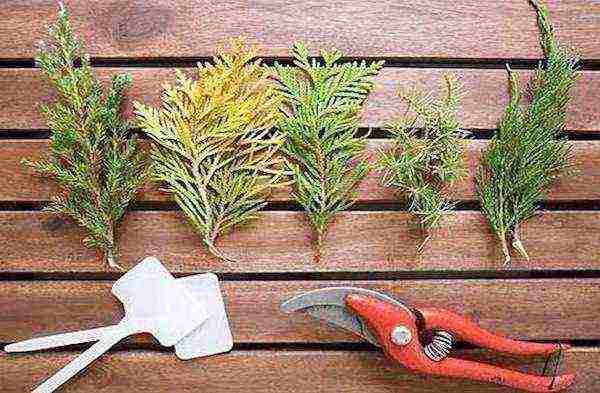 Compared to the method described above, propagation of a juniper by cuttings is easier. Plants that are at least 8 years old should be used as "donors".
Compared to the method described above, propagation of a juniper by cuttings is easier. Plants that are at least 8 years old should be used as "donors".
Cuttings about 10 cm long are cut in the spring. Next, they will need to be placed in a mixture of sand and peat. The container with cuttings is installed in a shaded place, covered with a film. The seedlings are constantly sprayed. After 2 months, roots are formed. Fortified, rooted specimens are transplanted into flowerpots.
Planting juniper in a pot
Having decided to plant a juniper in a pot, you need to make a hole in the ground in advance, the depth of which will be 2 times the height of the bush. It is best to use planting specimens with roots covered with a layer of soil.
The seedling is positioned in such a way that the top of the root earthen coma is 8 cm above the bottom of the soil excavation. When filling the hole with soil, you will need to gently hold the plant. Next, a careful compaction of the upper layer of soil is carried out, and it is sprinkled with a mulch layer of peat or humus.
Juniper care
Competently organized care of indoor juniper implies compliance with certain rules. The tips below will surely help you avoid many annoying mistakes.
Watering and spraying the plant
It is worth noting that moderate watering is recommended for junipers. In the summer, the soil in the flowerpot is moistened every two days after the drying of the top layer of the soil is revealed. In the cold season, the irrigation procedure is carried out twice a month.
The main condition is to prevent the land from drying out. You will need to make sure that the soil in the pot does not dry out, be sure to drain excess moisture from the pallet. In addition, it is necessary to spray the plant (in summer - every day, in winter every other day).
Carrying out fertilizing for the culture
When growing a juniper at home, you will need to feed it every 14 days during the period of its active growth (April - September). For this purpose, organic matter is added to the water used for irrigation. The use of humus has proven itself well. But for the introduction of mineral complexes, it should be done in very small doses.
Juniper pruning procedure
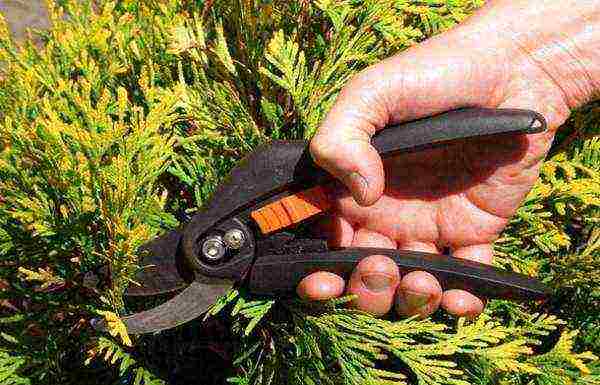 A growing juniper at home needs annual pruning, which ensures that it remains compact. As a rule, this event takes place in February. This procedure involves the removal of deformed, dried branches.
A growing juniper at home needs annual pruning, which ensures that it remains compact. As a rule, this event takes place in February. This procedure involves the removal of deformed, dried branches.
In order to form a plant, young shoots, the apical part, are pruned. This will contribute to giving the bush the necessary splendor, original shape (pyramid, cone), strengthening its health.
Transplanting a plant into another pot
Young decorative juniper is transplanted annually.
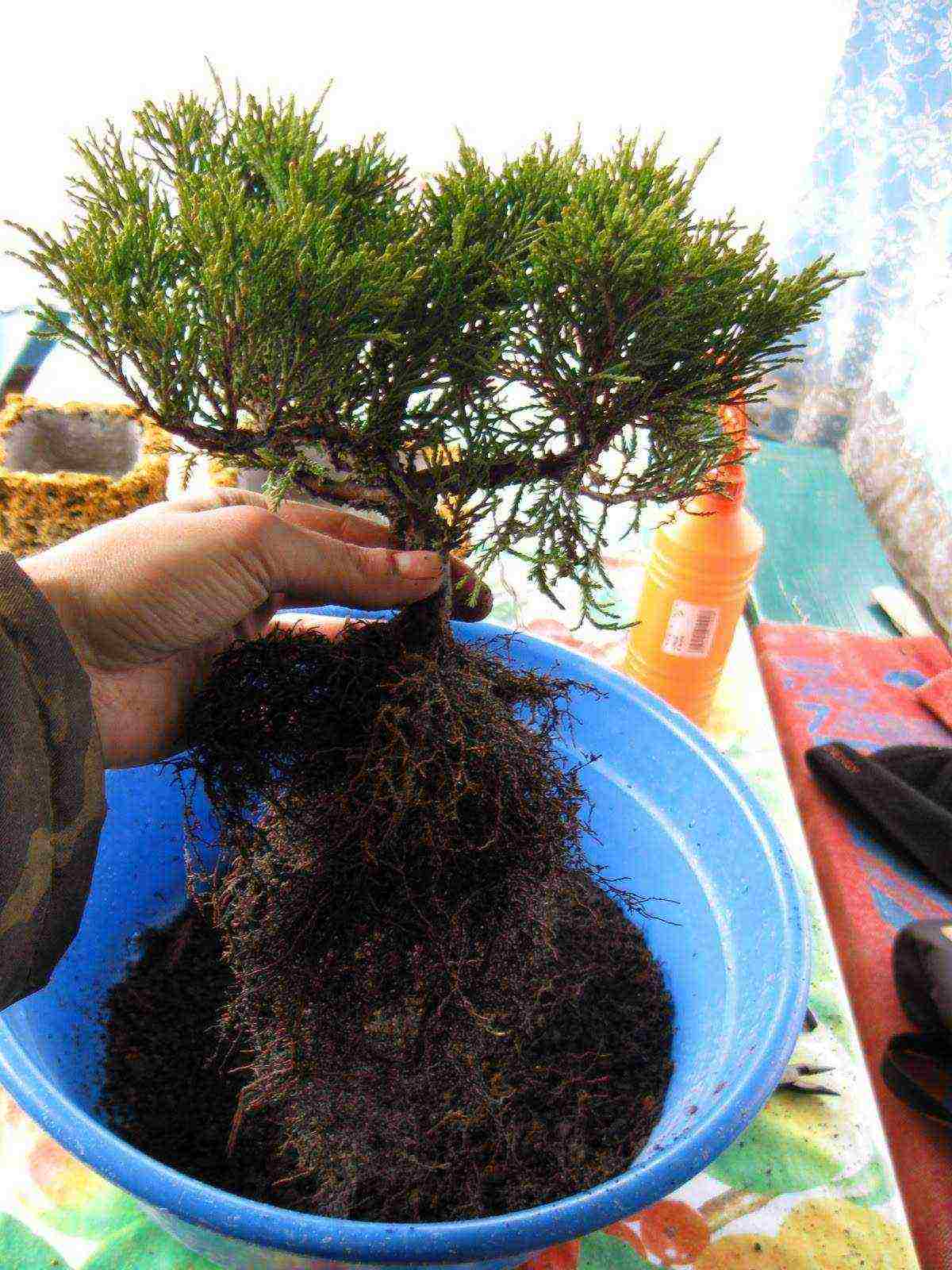 The optimal period for such an event is spring (mid-March). It is very important that the height of the plant does not exceed 1 m.
The optimal period for such an event is spring (mid-March). It is very important that the height of the plant does not exceed 1 m.
Initially, you will need, using a garden shovel, to carefully separate the soil in the area of \ u200b \ u200bthe walls (with the deepening of the tool to the middle of the pot). Next, you should remove the bush, gently holding it at the base, with a lump of earth. It is then placed in a new pot (in the prepared hole in the soil).
The dug hole should be twice the size of the earthen root ball. At the end of the procedure, the resulting voids in the recess are backfilled, and the soil is carefully tamped. The surface of the earth is covered with peat, crushed by the bark of a coniferous tree. The plant is watered.
Wintering juniper at home
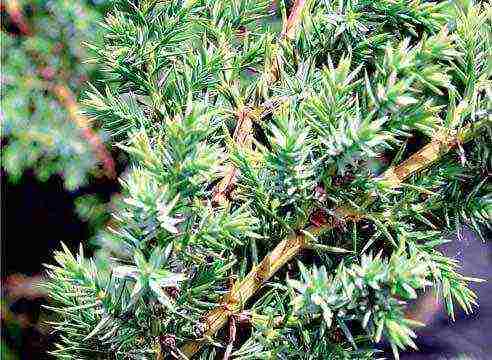 Winter care at home for a juniper has its own specifics. It should be noted that the plant is contraindicated to be near central heating devices. It is best to place the pot on a cool windowsill, insulated loggia.
Winter care at home for a juniper has its own specifics. It should be noted that the plant is contraindicated to be near central heating devices. It is best to place the pot on a cool windowsill, insulated loggia.
If there is hot, dry air in the apartment, a representative of the Cypress family needs to provide effective protection by wrapping the flowerpot in a polyethylene film. It is allowed to attach the edge of the transparent material along the window sill, and the other side is fixed on the upper window ledge. Complete closure of the plant, which prevents air from reaching it, is not encouraged.
Diseases and pests of culture
Having planted a juniper at home in a pot, you should not discount its possible defeat by various diseases and pests.
In particular, by spring, the bush can be significantly weakened due to the effect of dry air in winter. In summer, it reacts negatively to sunburn.
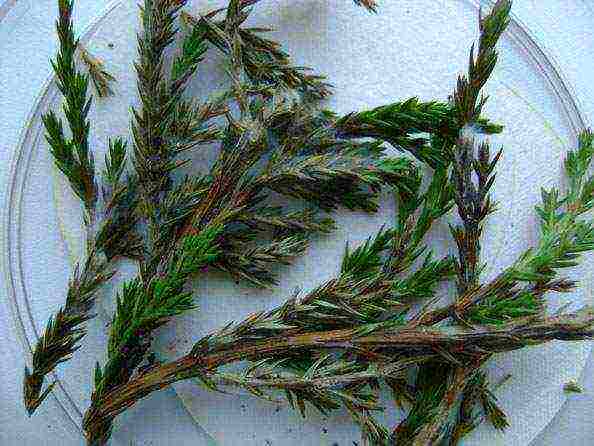 These factors are often the reasons for the negative impact of pathogenic infections, pathogenic microflora, pests. First of all, this is evidenced by yellowed, dying needles, after which the branches are damaged, and then the whole plant. Unfortunately, it is unlikely that it will be possible to save a bush with numerous clear signs of the disease.
These factors are often the reasons for the negative impact of pathogenic infections, pathogenic microflora, pests. First of all, this is evidenced by yellowed, dying needles, after which the branches are damaged, and then the whole plant. Unfortunately, it is unlikely that it will be possible to save a bush with numerous clear signs of the disease.
The affected branches must be pruned, destroyed, the remaining specimens must be carefully sprayed with fungicides. In the course of work, you need to use a pruner disinfected with alcohol.
For the needles, branches, fruits of the plant, the effect of the scale insect and its larvae is destructive. The juniper sawfly eats away the tissues of the bush from the inside. To get rid of pests, digging is carried out in the area of the trunk circle. Shoot moth caterpillars pose a danger to young branches. To destroy them, you will need to spray the juniper with insecticides.
The benefits of a plant for humans
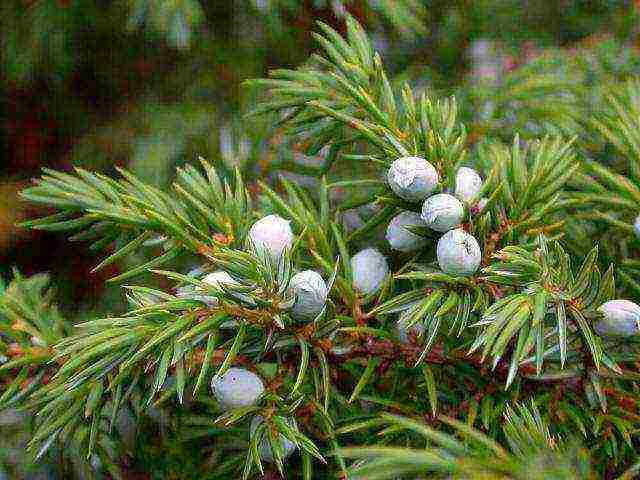 People have long paid attention to the useful properties of this representative of the Cypress family.The presence of juniper in the apartment will contribute to the creation of a unique atmosphere of comfort. Households who inhale its pine scent will certainly feel calm, and their sleep will become pleasant and strong.
People have long paid attention to the useful properties of this representative of the Cypress family.The presence of juniper in the apartment will contribute to the creation of a unique atmosphere of comfort. Households who inhale its pine scent will certainly feel calm, and their sleep will become pleasant and strong.
The cone berries of the plant contain a huge amount of healing substances, due to which they are used to prepare various healing decoctions and potions. In particular, the correct use of drugs based on them helps to improve the functioning of the urinary tract.
With the help of juniper resins, a whole range of skin diseases can be cured. 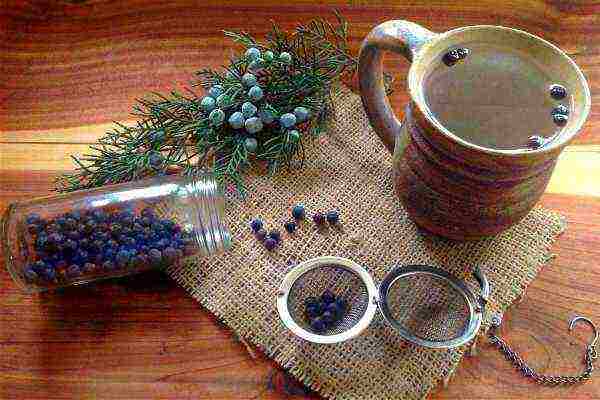 Taking drugs based on branches, needles of a plant will help in the fight against a number of ailments of viral origin.
Taking drugs based on branches, needles of a plant will help in the fight against a number of ailments of viral origin.
The intake of fresh berries relieves the condition of a large, suffering from stomach ulcers. The use of a decoction prepared from them makes it possible to cure liver diseases, rheumatism. Since ancient times, breastfeeding mothers have used juniper tincture to increase milk lactation.
Growing a juniper at home will be a lot of fun. The contemplation of this beautiful plant will bring aesthetic pleasure, and its wonderful aroma will contribute to the improvement of the atmosphere of the home. We advise you to view the article: Planting cherries with the main methods and rules for caring for it.


